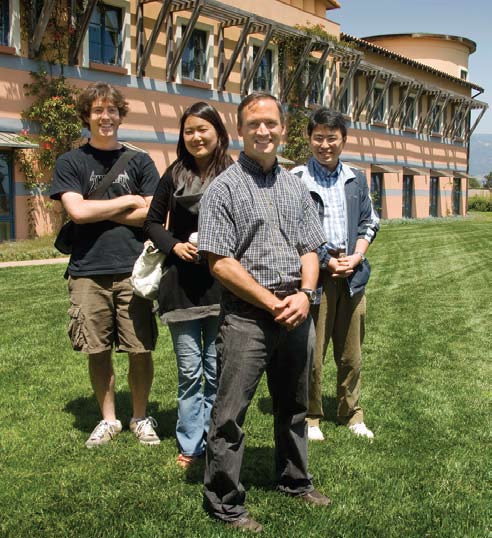 Leon Balents (front) and his physics graduate students Miles Stoudenmire (l), Sungbin Lee, and Gang Chen. Photo by Randall Lamb.
Leon Balents (front) and his physics graduate students Miles Stoudenmire (l), Sungbin Lee, and Gang Chen. Photo by Randall Lamb.
Condensed matter physicist Leon Balents has been appointed a permanent member of the KITP.
Sankar Das Sarma of the University of Maryland, who chairs the KITP advisory committee, served as chair of the search committee that chose Balents, who comes to the KITP from the UCSB Department of Physics.
Said Das Sarma, “We conducted an international search to fill the position. It certainly speaks well for the UCSB Physics Department that the best candidate we could find for the position was already on campus. We tried to identify a better candidate from the outside, but couldn’t. Leon is a superb condensed matter theorist. We think he will be an extraordinary asset to the KITP. He is young and brilliant and creative — just the right characteristics for guiding programming in the area of physics that represents more physicists than all other areas of physics combined, and that has the most profound impact on the direction of technological development and hence society.”
After obtaining a 1989 BS degree in physics and mathematics from MIT, Balents completed a 1994 PhD in physics from Harvard. He was a postdoctoral fellow at the then Institute for Theoretical Physics (ITP) at Santa Barbara from 1994 to 1998. After a year as technical staff member at Bell Laboratories, he joined the UCSB Physics Department in 1999, was promoted to the tenured position of associate professor in 2001 and to professor in 2002.
Balents said that his ITP postdoctoral fellowship “was by far the most important experience in my career. Coming here from Harvard was such a change in atmosphere and level of activity that it took my breath away.”
His experiences at the ITP converted Balents from soft- to hard-condensed-matter theory. “I got into soft condensed matter to start with,” he said, “because it was very accessible. With advanced mathematics, you could get in and just attack research problems.”
Condensed matter physics is largely concerned with the study of materials — i.e., matter that is “condensed” or holds itself together, which largely means solids and liquids. A handy way of distinguishing soft from hard-condensed-matter theory is that the former deals with problems in which quantum mechanics is not essential; whereas with problems in hard condensed matter, quantum mechanics is more the rule than the exception.
“Like most other things in physics,” said Balents, “it comes down to energy scales and length scales. What makes a material hard are very strong forces holding the particles together, and the basic forces that hold atoms together are very strong. In soft materials the building blocks are bigger — not individual atoms but large molecules or polymers — and the residual forces between the molecules are weaker, and that makes them hold themselves together not as strongly, so that their behavior is more classical than quantum mechanical.”
One great standing problem in hard-condensed-matter theory is to understand how certain cuprates (copper-oxide materials), discovered experimentally some 20 years ago, superconduct. What excites Balents now is the discovery of an entirely new class of superconductors that are iron-arsenide based. Chemists in Japan and China made the discovery two years ago, and condensed matter theorists took notice about six months ago. By comparing and contrasting the iron-arsenides with the cuprates, said Balents, “We could really learn a lot about this general phenomenon,” and maybe even make the potential theoretical breakthrough that has been the goal for so many condensed matter theorists for two decades.
“Another pretty exciting development, which is different and actually pretty heavily driven by theory rather than experiment,” he said, “is the realization that there can be physics similar to the quantum Hall effect in two- and three-dimensional materials in zero magnetic field as a result of spin orbit interactions. Spin orbit is a kind of relativistic effect that usually is not very important in solids, but is an integral part of the Dirac equation that you would use if you were doing high energy physics,” explains Balents.
Though it would take a lot of effort to explain how, this development relates to a possible whole new technology that would use the spin of particles. All of modern technology (with a very few spin-based exceptions) makes use of the charge of particles.
Balents, who confesses, “I am a little backward in personal technology; I rarely use a cell phone,” nonetheless is engaged in laying the intellectual infrastructure for transformative technologies. “Yes,” he said, “I do get glimpses of technologies to come. Envisioning them is a big part of the motivation ultimately. I like to sit back and ask myself what would make, not an incremental improvement, but an order of magnitude change.”
Of his KITP appointment, Balents said, “For years I’ve looked at the permanent members as scientific heroes. I am thrilled to be one. What a fantastic environment for doing science right in the middle of all these active programs, and working with the top postdocs from around the world and with such wonderful colleagues.”
Balents has served as an organizer of two KITP programs: “Exotic Order and Criticality in Quantum Systems” in 2004, and “Moments and Multiplets in Mott Materials” last fall.
The recipient of an NSF Career Award, he has also been awarded Sloan Foundation and Packard Foundation fellowships.
